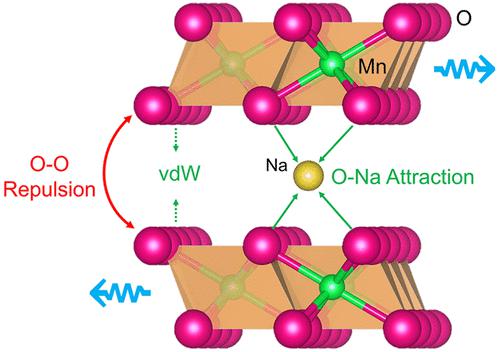当前位置:
X-MOL 学术
›
Acc. Mater. Res.
›
论文详情
Our official English website, www.x-mol.net, welcomes your feedback! (Note: you will need to create a separate account there.)
Synthesis, Structure, Electrochemical Mechanisms, and Atmospheric Stability of Mn-Based Layered Oxide Cathodes for Sodium Ion Batteries
Accounts of Materials Research ( IF 14.6 ) Pub Date : 2022-05-31 , DOI: 10.1021/accountsmr.2c00058 Wenhua Zuo 1, 2 , Yong Yang 1
Accounts of Materials Research ( IF 14.6 ) Pub Date : 2022-05-31 , DOI: 10.1021/accountsmr.2c00058 Wenhua Zuo 1, 2 , Yong Yang 1
Affiliation

|
The commercialization of lithium ion batteries (LIBs) triggered a new era of portable electronics and electric vehicles, which changed our daily life remarkably. Meanwhile, LIBs are promising as large-scale storage batteries in green electric grids by using renewable energy as the primary energy source. Driven by the concerns of lithium depletion and the turbulent price of Li, Ni, and Co mineral resources, sodium ion batteries (NIBs) have been intensively investigated and are becoming a strong competitor for large-scale energy storage, such as in national grids. As an inevitable component of NIBs, the cathode determines all of the critical properties of NIBs, such as cost, safety, energy/power densities, and cycling life, and an ideal cathode material should be sustainable and easy-to-use in scalable production, transportation, and storage. Layered sodium transition metal oxide (NaxTMO2), especially the Mn-based NaxTMO2, has been chosen as a family of leading cathodes for the upcoming commercial NIBs because of a great variety of compositions and redox-active elements, such as Mn, Fe, Cu, Ni, Co, Cr, Ir, Ru, and even O. The success or failure of the commercialization of these materials relies on the resolution of two critical challenges. The first is the electrochemical irreversibility related to the phase transformations and electrolyte decomposition during repeated charging and discharging processes. The second challenge is the chemical and structural sensitivity when Mn-based NaxTMO2 is exposed to moist air. These air-sensitive oxides need to be prepared and stored in inert or dry atmospheres, thus increasing the costs of production, storage, and transportation. During the past decade, we focused on investigating the degradation mechanisms and exploring effective strategies to enhance the atmospheric stability and electrochemical reversibility of Mn-based NaxTMO2. In addition, the materials synthesis and charge-compensation mechanisms, which are critical to the electrochemical characteristics of sodium layered oxides, have also been taken into consideration in our research.
中文翻译:

钠离子电池用锰基层状氧化物阴极的合成、结构、电化学机理和大气稳定性
锂离子电池 (LIB) 的商业化开启了便携式电子产品和电动汽车的新时代,极大地改变了我们的日常生活。同时,LIBs 有望成为绿色电网中的大型蓄电池,以可再生能源为主要能源。在锂耗竭的担忧和锂、镍、钴矿产资源价格动荡的推动下,钠离子电池(NIB)受到了深入研究,并正在成为大规模储能(如国家电网)的有力竞争者。作为 NIB 不可避免的组成部分,正极决定了 NIB 的所有关键特性,例如成本、安全性、能量/功率密度和循环寿命,理想的正极材料应该是可持续的且易于在规模化生产中使用、运输和储存。x TMO 2 ),尤其是 Mn 基 Na x TMO 2,由于其成分和氧化还原活性元素种类繁多,如 Mn、Fe、Cu、 Ni、Co、Cr、Ir、Ru,甚至 O。这些材料商业化的成败取决于两个关键挑战的解决。首先是与重复充放电过程中的相变和电解质分解相关的电化学不可逆性。第二个挑战是 Mn 基 Na x TMO 2时的化学和结构敏感性暴露在潮湿的空气中。这些对空气敏感的氧化物需要在惰性或干燥的气氛中制备和储存,从而增加了生产、储存和运输的成本。在过去的十年中,我们专注于研究降解机制并探索有效策略以提高 Mn 基 Na x TMO 2的大气稳定性和电化学可逆性。此外,我们的研究还考虑了对钠层状氧化物的电化学特性至关重要的材料合成和电荷补偿机制。
更新日期:2022-05-31
中文翻译:

钠离子电池用锰基层状氧化物阴极的合成、结构、电化学机理和大气稳定性
锂离子电池 (LIB) 的商业化开启了便携式电子产品和电动汽车的新时代,极大地改变了我们的日常生活。同时,LIBs 有望成为绿色电网中的大型蓄电池,以可再生能源为主要能源。在锂耗竭的担忧和锂、镍、钴矿产资源价格动荡的推动下,钠离子电池(NIB)受到了深入研究,并正在成为大规模储能(如国家电网)的有力竞争者。作为 NIB 不可避免的组成部分,正极决定了 NIB 的所有关键特性,例如成本、安全性、能量/功率密度和循环寿命,理想的正极材料应该是可持续的且易于在规模化生产中使用、运输和储存。x TMO 2 ),尤其是 Mn 基 Na x TMO 2,由于其成分和氧化还原活性元素种类繁多,如 Mn、Fe、Cu、 Ni、Co、Cr、Ir、Ru,甚至 O。这些材料商业化的成败取决于两个关键挑战的解决。首先是与重复充放电过程中的相变和电解质分解相关的电化学不可逆性。第二个挑战是 Mn 基 Na x TMO 2时的化学和结构敏感性暴露在潮湿的空气中。这些对空气敏感的氧化物需要在惰性或干燥的气氛中制备和储存,从而增加了生产、储存和运输的成本。在过去的十年中,我们专注于研究降解机制并探索有效策略以提高 Mn 基 Na x TMO 2的大气稳定性和电化学可逆性。此外,我们的研究还考虑了对钠层状氧化物的电化学特性至关重要的材料合成和电荷补偿机制。


























 京公网安备 11010802027423号
京公网安备 11010802027423号